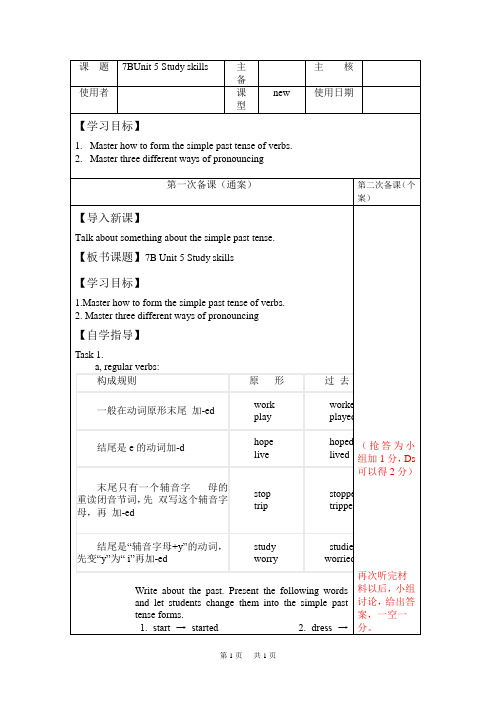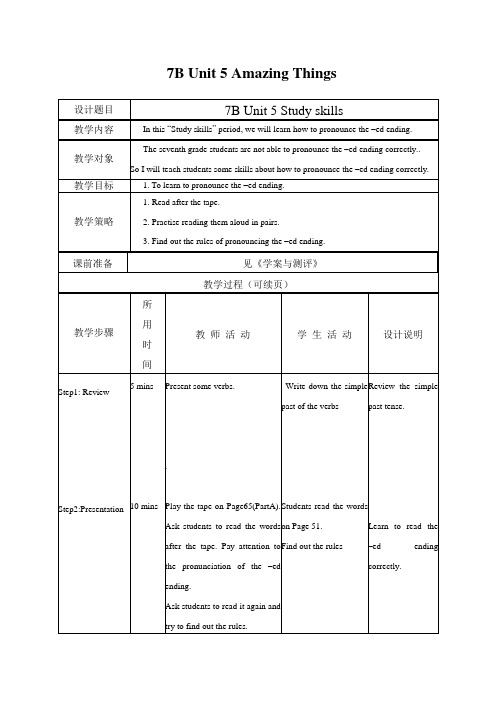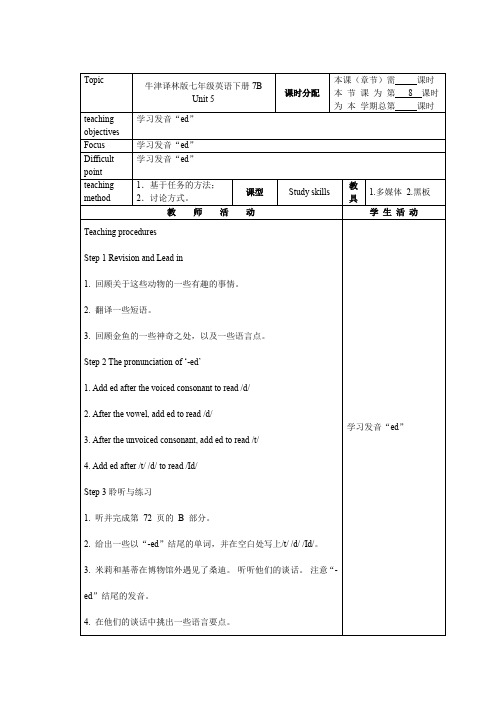7Bu5《-study》教学设计-优秀教案
- 格式:doc
- 大小:33.50 KB
- 文档页数:2

dressed3. play → played4. help → helped5. use → used6. like → liked7. look → looked 8. study → studied9. plan → planned 10. cry → criedThen ask students to fill in the blanks with the pasttense forms of these words. Ask several students toshare their answers.b, irregular verbs:We form the simple past tense of irregular verbs differently. We do not add ‘ –ed’No changeChange the vowelChange the consonantChange the vowels and the consonants cost-cost, put-put come-came, ring- rang make-made, send-sent do-did, buy-boughtThen give students some words and change them into the past forms. If they don’t know , they ca n check the wordlist on Page 121.1. look looked2. live lived3. stop stopped4.carry carried5. hope hoped6. trip tripped7. call called 8. finish finished 9. want wanted10.are were 11.go w ent 12.have had13.do did 14.get got e came16.say said 17.see saw 18.put put19.eat ate 20.take took 21.read read Ask several students to write down the answers. Then check the answers in a whole.Tell them they must use the simple past tense form ofthe verbs. If they don’t know the past tense formsof these words, they can check the wordlist onPage 106-107.Task 2.Saying ‘-ed’ endingsMost verbs in the simple past tense form have ‘-ed’ endings . However, we pronounce these endings differently: /t/, /d/ or /id/ . 1.How do you pronounce the following ending ? Listen carefully and repeat these words .2.How do you pronounce the ending of these words ? Listen carefully and write / t / , / d / or / id / in the blanks in Part B.动词+ed的发音1.动词原形以清辅音结尾,ed读作/t/2.动词原形以浊辅音或元音结尾,ed读作/d/。





课题7BUnit 5 Study skills 主备主核使用者课型new 使用日期【学习目标】1.Master how to form the simple past tense of verbs.2.Master three different ways of pronouncing第一次备课(通案)第二次备课(个案)【导入新课】Talk about something about the simple past tense.【板书课题】7B Unit 5 Study skills【学习目标】1.Master how to form the simple past tense of verbs.2. Master three different ways of pronouncing【自学指导】Task 1.a, regular verbs:构成规则原形过去式一般在动词原形末尾加-ed workplayworkedplayed结尾是e的动词加-d hopelivehopedlived末尾只有一个辅音字母的重读闭音节词,先双写这个辅音字母,再加-ed stoptripstoppedtripped结尾是“辅音字母+y”的动词,先变“y”为“ i”再加-ed studyworrystudiedworriedWrite about the past. Present the following words and let students change them into the simple past tense forms.1. start → started2. dress → (抢答为小组加1分,Ds 可以得2分)再次听完材料以后,小组讨论,给出答案,一空一分。
dressed3. play → played4. help → helped5. use → used6. like → liked7. look → looked 8. study → studied9. plan → planned 10. cry → criedThen ask students to fill in the blanks with the pasttense forms of these words. Ask several students toshare their answers.b, irregular verbs:We form the simple past tense of irregular verbs differently. We do not add ‘ –ed’No changeChange the vowelChange the consonantChange the vowels and the consonants cost-cost, put-put come-came, ring- rang make-made, send-sent do-did, buy-boughtThen give students some words and change them into the past forms. If they don’t know , they ca n check the wordlist on Page 121.1. look looked2. live lived3. stop stopped4.carry carried5. hope hoped6. trip tripped7. call called 8. finish finished 9. want wanted10.are were 11.go w ent 12.have had13.do did 14.get got e came16.say said 17.see saw 18.put put19.eat ate 20.take took 21.read read Ask several students to write down the answers. Then check the answers in a whole.Tell them they must use the simple past tense form ofthe verbs. If they don’t know the past tense formsof these words, they can check the wordlist onPage 106-107.Task 2.Saying ‘-ed’ endingsMost verbs in the simple past tense form have ‘-ed’ endings . However, we pronounce these endings differently: /t/, /d/ or /id/ . 1.How do you pronounce the following ending ? Listen carefully and repeat these words .2.How do you pronounce the ending of these words ? Listen carefully and write / t / , / d / or / id / in the blanks in Part B.动词+ed的发音1.动词原形以清辅音结尾,ed读作/t/2.动词原形以浊辅音或元音结尾,ed读作/d/ 学生活动指导:三分钟的准备时间,答对一个可为小组加1分小组活动指导:讨论语言点。
七年级英语下册Unit5教学设计与教学反思⽇志⼀、教材分析本单元是Go for it ( 下 ) Unit 5。
主要围绕“What are you doing?”这⼀主题展开各种教学活动,并以这⼀主题引出现在进⾏时的⼀般疑问句,否定句以及特殊疑问句等语⾔功能。
本单元旨在创造⼀个轻松、愉快的学习、交流环境,通过听、说、读、写来培养学⽣综合运⽤这些知识的能⼒。
并让学⽣能在“做中学”(learning by doing),通过有限的课堂实践活动,注意观察别⼈的⾏动,能准确地⽤英语来表达。
SectionA 1a--1c部分是本单元的第⼀课时,这⼀课时通过常见的⼀些动词短语引出现在进⾏时的教学,学好本课对以后的SectionB部分的学习起了很好的铺垫作⽤。
⼆、教学⽬标1.语⾔⽬标1)短语和单词doing homework, watching TV, cleaning, eating dinner, reading a book, talking on the phone, apartment2)句型结构What are you doing?I'm watching TV.What's he/she doing? He/She's reading.What are they doing ? They're watching TV.3)语法The structure of the Present Progressive TenseThe present participle2.语⾔技能1)能⽤现在进⾏时的各种形式进⾏准确的描述和表达正在发⽣的动作。
2)能掌握现在进⾏时态及⼀些表⽰具体动作的词组搭配,如:doing homework, watching TV, eating dinner… 等。
3、学习策略通过本节课的教学,我要求学⽣能通过观察别⼈的⾏为和活动时能⽤现在进⾏时来准确地表达所发⽣或进⾏的动作。